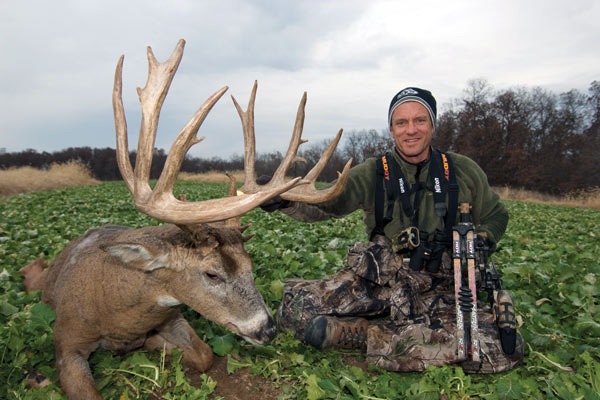March 21, 2016
By Bill Winke
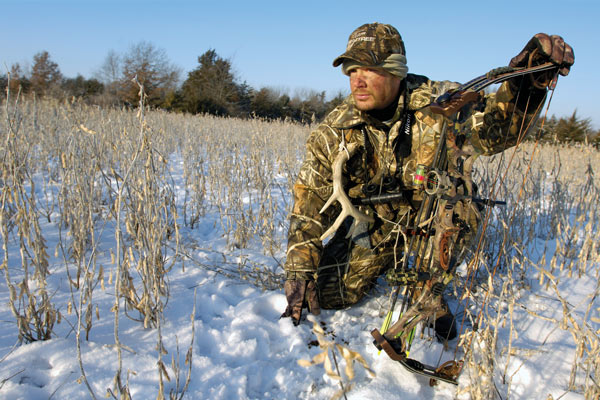
When there is a certain buck I want to get the antlers from, I show real enthusiasm and some creativity. But I have a hard time walking miles looking for antlers. Within minutes I am scouting, and soon I am spending more time looking at sign and possible stand sites than I am for antlers.
For me, it is really hard to separate shed hunting from deer hunting.
So, I am no expert shed hunter. However, I do have friends who love shed hunting for its own sake and I have learned a lot from them. In fact, every year for the past decade, a group of friends has converged on my property to sweep up the antlers. I love this time because I get to see what is out there — and what is lying dead — and I can learn a lot about how to hunt the farm the next year without walking all those miles to gain the information first hand.
Advertisement
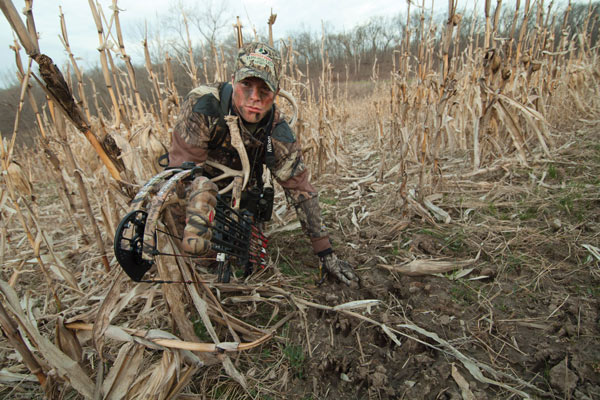
In this feature, I will offer a few tips about shed hunting from my own experience and a few tips from friends. In the end, I hope I can wrap a nice bow around it all and show how shed hunting will make you better at killing the bucks that dropped them.
I am going to start with tips from my friend Lee Murphy — the most devoted shed hunter I have ever met. Lee lives in the Twin Cities metropolitan area of Minnesota and began looking for shed antlers in 1971. Until recent years when age and declining health have slowed him somewhat, he spent at least 100 days each spring combing the hills and draws of many Midwestern states. Tens of thousands of hours spent dissecting prime whitetail habitat have taught him a few things about deer.
Advertisement
Finding Shed Antlers
Hunting shed antlers in areas where deer don't migrate to traditional deer yards is little different from hunting the deer themselves. You have the best success finding antlers in the places where the deer spend the most time — the same philosophy that you must use when hunting during the fall. So, the first step in becoming a good antler hunter is to become a good deer hunter. Lee Murphy's philosophies as a deer hunter and as an antler hunter overlap almost perfectly.
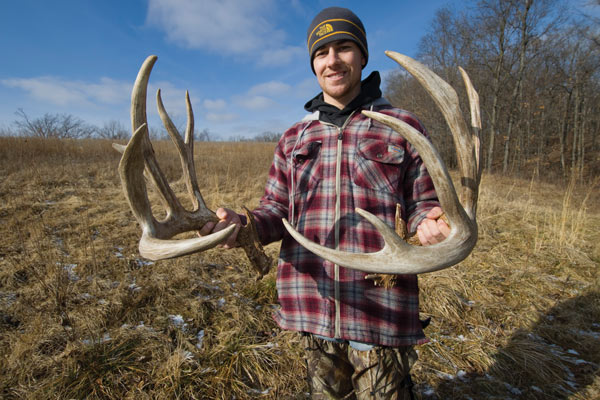
"I focus on the same things when I'm hunting antlers that I focus on when hunting deer," said Lee. "The feeding and bedding areas and the trails and bottlenecks in between. The biggest difference between fall and winter is in where the deer bed. During the winter, deer tend to bed in more open cover where the sun hits them directly. I believe that's why I don't find many antlers in the thick stuff. They may be in those thick areas during the fall, but not much during the winter. Also, deer bed heavily on south-facing slopes about three quarters of the way to the top. The sun keeps them warmer and the slope protects them from any cold north winds. I find a lot of antlers in these places.
"Look for fresh deer droppings on the trails when you are scouting or antler hunting. Fresh droppings mean the deer are using the area right now, and that is where you should spend your time, whether you're hunting the deer in the fall or their antlers in the winter and spring. If you are scouting or antler hunting in a new area, pay close attention to where you find those droppings. Slow down once you get in these areas. I find a lot of antlers along the trails that have the most droppings."
Shed Dogs
I have another friend named Allen Currin who owns land near my home. A few years ago, Allen and his best friend stopped by to put on a shed antler hunting demonstration. Normally, a couple of men picking up antlers that I had planted for them to find would bore me to tears. Surely, my life has not dipped to this level, has it? However, this demonstration was different and I couldn't wait to see it play out. The main character in the hunt was not a man at all, but a 3-year old yellow Lab named Roxie that was specially trained to find shed antlers by scent.
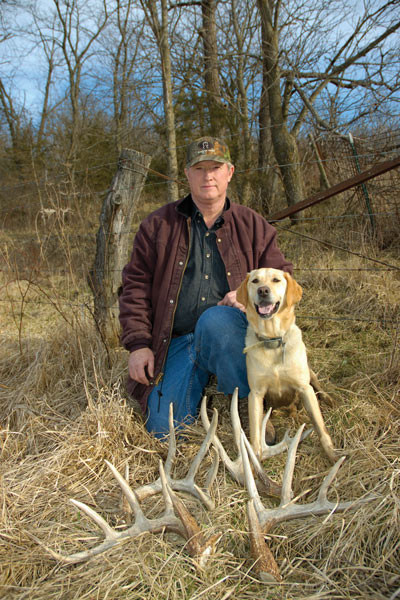 In the back of Allen's truck was a plastic bag filled with shed antlers — some fresh, others old. Allen did his best to keep them away from outside odors so the dog would only be able to smell the antlers and not human scent.
In the back of Allen's truck was a plastic bag filled with shed antlers — some fresh, others old. Allen did his best to keep them away from outside odors so the dog would only be able to smell the antlers and not human scent.
I packed the bag of bones out to an 11-acre CRP field grown waist-high in small oak trees and brome grass. It was a tough testing ground. If you have ever laid down in a thick, grassy field, you know what I mean. Very little wind hits your body. If Roxie was going to find these antlers by scent, she was going to have to be pretty darn good at it. Besides, I didn't hide any of the five antlers in an open spot where the dog could possibly see them. I stuffed them down into the grass.
Allen walked Roxie to the downwind edge of the field and cut her loose. She took off with all the enthusiasm of a 3-year old and began covering ground like a pointer working a quail field. It wasn't long before her head whipped to the right, her tail started twitching and she turned "birdy." Roxie found the first two antlers with ease. As she worked her way across the field, she soon found the third antler, but I had to help her find the fourth with a little coaxing. I actually forgot where I hid the fifth, which was a little unnerving to Allen because these were some pretty darn nice antlers. Finally, the dog and I found it at about the same time.
Each time Roxie found an antler she sat down next to it. She wasn't trained to retrieve or bark, but rather to sit until Allen arrived to give her the reward.
"She doesn't care one bit about these antlers," Allen told me when he walked up to the first find. "What she really loves is this yellow ball right here."
Allen produced a tennis ball from his jacket pocket and pitched it 100 feet several times for Roxie to chase. It was obvious that she loved that ball. As soon as she saw it, her eyes lit up and when Allen chucked it, she was off in a yellow blur. Three times, he played the game with Roxie, heaping heavy praise on her, and then the ball went back in the pocket and Roxie went back to work.
"I wanted a dog that would find the antlers by scent," Allen said. "If the antlers are visible I can find them myself. I don't need any help when they are right out in the open. But when they are in CRP grass or buried in brush, that's when a dog really comes in handy."
How Effective Are They?
"To appreciate what Roxie can do, you really need to watch her in a natural setting where she isn't hunting planted antlers," said Allen. "Let me give you an example of a shed hunt we did recently. My friend was walking with me. He yelled that he saw an antler up ahead. We always let the dog find all the antlers we can in order to keep her interested and to improve her abilities through practice. I was getting ready to guide Roxie in that direction when she disappeared.
"Bob yelled, 'It's over here. She's not even close.' When I got to Roxie, I could see that she was lying down. I couldn't see an antler, but figured there must be one there somewhere. When I got right up to her, I saw an antler tine just sticking out of the grass. It was an antler from the previous spring, buried in the grass. I dug it out, let her retrieve the ball and pointed her back toward Bob again.
"She nearly got to him before she laid down again. This time she was laying right next to a 2€‰1„2-inch spike antler shed. It is the shortest antler I have ever found. I rewarded her and finally she made it to the antler Bob had seen. Roxie found two antlers in a short time that we never would have found. Roxie finds about 40 percent of our total number of antlers each spring."
There is a lot of information on the web about how to train a dog to find sheds. One of the better systems is called Dog Bone.
Sometimes you just get lucky and they teach themselves how to do it. One of our dogs found a dozen antlers last spring while making short forays from the backyard. I am sure that my friends who walked that area repeatedly were embarrassed by how many they missed. Unfortunately, we had to put Joe to sleep this summer after he suffered kidney failure brought on by Lyme disease.
My Best Story
Serious shed hunters have stories of great days afield just like we do when hunting the deer themselves. I am not a serious shed hunter, but I am going to relay my best day of shed hunting because it is pretty cool and actually teaches something you might find interesting.
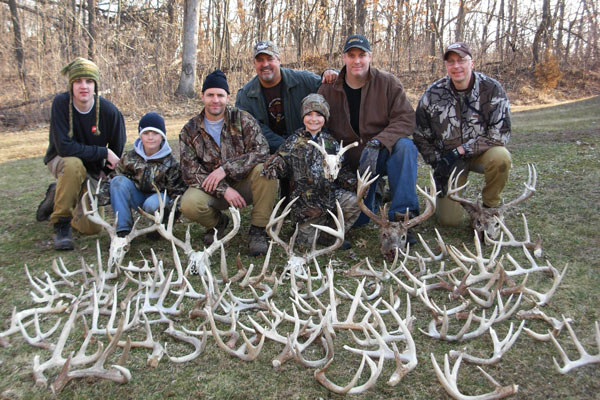
Back in 2011, I was hunting a giant buck that lived on our farm. I had hunted the deer for two seasons already and had gotten very close to killing him that year. He was a huge 5x6 typical that scored well over 200 inches. After he got away during the late season, I made it my mission to find his sheds.
I knew right where he lived, but I didn't want to start walking that area until I was sure he had dropped the antlers. I didn't want to push him out and risk having him drop an antler who knows where. At the same time, I didn't want to let them lay on the ground for any length of time either because I didn't want the squirrels to nibble on them. So, I ran a trail camera on the fringe of his core area over a small pile of corn. I checked it every two days until he showed up one day without his antlers. I mobilized my friends and we combed the area the next morning — finding both sides within two days of the buck dropping them!
That may be extreme for most bowhunters, but it was cool to do it. The trail camera also tells you something about where the buck is bedding — a likely place to start looking for antlers — because his butt will be pointing in that direction on the first photo you get of him in the evenings. It worked like a charm for me. We found one antler in his bedding area and one in his feeding area.
Hunting the Bucks
Where deer spend the winter — in areas where they don't migrate — is a good indication of where they actually live. Summer sightings can be deceiving. At that time, you may see a nice buck on a bean field, but when the bachelor groups break up and the bucks disperse to their normal fall ranges, he may end up on a nearby property that you can't hunt.
Similarly, sightings during the rut can also fool you. Bucks tend to roam during the rut. You may see a nice buck in November in your hunting area and start hunting him. But, once again, he may actually spend most of his time a mile or more away. If you start hunting him based on one sighting during the rut, you could spend the rest of your life without seeing him again.
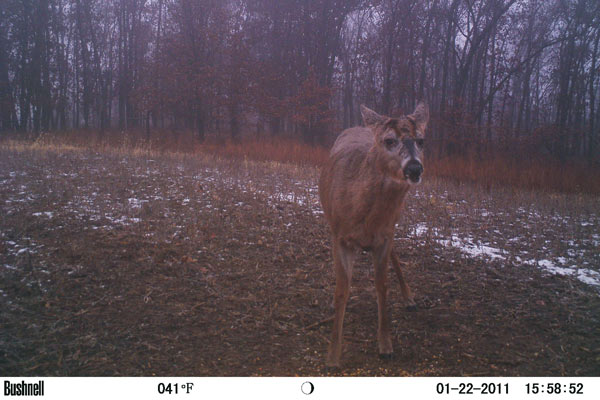
On the other hand, when you find a shed antler, you have found a clue about where the buck wintered. You know a portion of the buck's home range — one place where he is likely to spend time in the fall. That general area is a good place to hunt. Not surprisingly, the place where we found one of that giant buck's antlers after the 2011 season was within 60 yards of where he was standing when I finally killed him 2012!
Lee Murphy has found at least one shed antler from many of the bucks he has taken with a bow. These experiences should be reason enough to take the location of shed antlers seriously.
"When I find a shed from a nice buck in an area that I can hunt," Lee said, "I use it as a reference point for my fall hunting. I'll keep that place in mind when deciding where to hang my stands. When I'm shed antler hunting I'm also scouting. Even if it's a farm I can't hunt, I'm always studying deer sign and terrain. When I find a great looking spot, I'll start looking in the trees. Often, I'll find a treestand nearby.
"When I'm specifically scouting for stand locations, I'll start by finding the feeding areas. Then, I learn as much as I can about the area. I don't want to put up a stand until I know every trail and every crossing in the entire area. Many bowhunters make the mistake of focusing only on the small area around their potential stand site. I want to know everything."
I have sheds from nearly all the bucks I have shot in the past five or six years. Some of them were antlers that my friends found for me. It is amazing how I end up shooting those bucks very near the areas where they dropped their sheds the winter before. If you thought antler hunting had nothing to do with deer hunting, think again. If you hunt an area where the deer don't migrate, the places where you find shed antlers should factor into where you actually hang your stands next fall.
